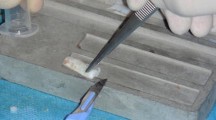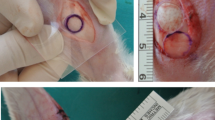Abstract
Purpose
In this study, we proposed a “sliced-partial thickness cartilage graft” for nasal contour restoration purposes and compared the long-term graft survival and histological changes of sliced, crushed, and intact cartilage grafts.
Methods
Nasal septal and auricular cartilage grafts were harvested from 8 rabbits. Sliced, crushed, or intact cartilage grafts were measured in thickness with a micrometer and re-implanted. 4 months later, specimens were histologically evaluated and thickness were measured.
Results
Both nasal septal and auricular crushed cartilage lost significantly more chondrocytes than sliced samples together with fibrosis, multiple fracture lines, and even ossification. Sliced and intact cartilages were histologically similar except sliced cartilage had some minor changes limited to its cut surface. Sliced cartilages retained their thickness, histology, and structural properties in the long term similar to intact cartilages whereas -contrary to expectations- crushed specimens had significantly higher thickness measurements at the end of 4 months.
Conclusion
Sliced cartilage grafts prepared with an atraumatic cartilage slicer are an ideal camouflaging material with its uniform thickness, and malleability. Crushed cartilages seemingly getting thicker without histological findings could be explained by lower than actual initial measurements due to its structural weakness and getting squeezed when the standard pressure of the micrometer was applied.




Similar content being viewed by others
Availability of data and material
All raw data, pictures and histological material are available upon request.
References
Cakmak O, Altintas H (2010) A classification for degree of crushed cartilage. Arch Facial Plast Surg 12:435–436. https://doi.org/10.1001/archfacial.2010.80
Pfander D, Gelse K (2007) Hypoxia and osteoarthritis: how chondrocytes survive hypoxic environments. Curr Opin Rheumatol 19:457–462. https://doi.org/10.1097/BOR.0b013e3282ba5693
Cakmak O, Buyuklu F (2007) Crushed cartilage grafts for concealing irregularities in rhinoplasty. Arch Facial Plast Surg 9:352–357. https://doi.org/10.1001/archfaci.9.5.352
Belaldavar BP, Mudhol RS, Dhorigol V, Belaldavar C, Desai S, Garg R, Deshmukh O, Sinha M, Ganesh S (2016) Study of outcome of an implanted autologous auricular cartilage: a preliminary experimental research in rabbits. Indian J Otolaryngol Head Neck Surg 68:11–15. https://doi.org/10.1007/s12070-015-0935-3
Fatemi MJ, Hasani ME, Rahimian S, Bateni H, Pedram M, Mousavi SJ (2012) Survival of block and fascial-wrapped diced cartilage grafts: an experimental study in rabbits. Ann Plast Surg 69:326–330. https://doi.org/10.1097/SAP.0b013e3182275d6a
Haberal Can I, Atilla P, Cakar AN, Onerci M (2008) An animal study on cartilage healing using auricular cartilage as a model. Eur Arch Otorhinolaryngol 265:307–311. https://doi.org/10.1007/s00405-007-0455-1
Rudderman RH, Guyuron B, Mendelsohn G (1994) The fate of fresh and preserved, noncrushed and crushed autogenous cartilage in the rabbit model. Ann Plast Surg 32:250–254. https://doi.org/10.1097/00000637-199403000-00004
Garg R, Shaikh M, Foulad A, Wong B (2010) Chondrocyte viability in human nasal septum after morselization. Arch Facial Plast Surg 12:204–206. https://doi.org/10.1001/archfacial.2010.35
Boccieri A, Marianetti TM, Pascali M (2018) Crushed cartilage: a rescue procedure in rhinoplasty. J Craniofac Surg 29:614–617. https://doi.org/10.1097/SCS.0000000000004333
Brenner KA, McConnell MP, Evans GR, Calvert JW (2006) Survival of diced cartilage grafts: an experimental study. Plast Reconstr Surg 117:105–115. https://doi.org/10.1097/01.prs.0000195082.38311.f4
Hizal E, Buyuklu F, Ozer O, Cakmak O (2011) Effects of different levels of crushing on the viability of rabbit costal and nasal septal cartilages. Plast Reconstr Surg 128:1045–1051. https://doi.org/10.1097/PRS.0b013e31822b6651
Kreutzer C, Hoehne J, Gubisch W, Rezaeian F, Haack S (2017) Free diced cartilage: a new application of diced cartilage grafts in primary and secondary rhinoplasty. Plast Reconstr Surg 140:461–470. https://doi.org/10.1097/PRS.0000000000003622
Daniel RK (2008) Diced cartilage grafts in rhinoplasty surgery: current techniques and applications. Plast Reconstr Surg 122:1883–1891. https://doi.org/10.1097/PRS.0b013e31818d2104
Trivisonno A, Cohen SR, Magalon G, Magalon J, Sterodimas A, Pascali M, Cervelli V, Toietta G, Colaprietra A, Calcagni F, Orlandi A, Scioli MG, Gentile P (2019) Fluid cartilage as new autologous biomaterial in the treatment of minor nose defects: clinical and microscopic difference amongst diced, crushed, and fluid cartilage. Materials (Basel). https://doi.org/10.3390/ma12071062
Parelkar K, Thorawade V, Marfatia H, Shere D (2020) Endoscopic cartilage tympanoplasty: full thickness and partial thickness tragal graft. Braz J Otorhinolaryngol 86:308–314. https://doi.org/10.1016/j.bjorl.2018.12.006
McCleve DE (1969) Tragal cartilage reconstruction of the autidoty canal. Arch Otolaryngol 90:271–274. https://doi.org/10.1001/archotol.1969.00770030273005
Ergun O, Bajin MD, Sargon MF, Sennaroglu L (2017) Hacettepe cartilage slicer: a novel cartilage slicer and its performance test results. J Laryngol Otol 131:671–675. https://doi.org/10.1017/S0022215117000846
Yung M (2008) Cartilage tympanoplasty: literature review. J Laryngol Otol 122:663–672. https://doi.org/10.1017/S0022215108001813
Khan MM, Parab SR (2015) Average thickness of tragal cartilage for slicing techniques in tympanoplasty. J Laryngol Otol 129:435–439. https://doi.org/10.1017/S0022215115000055
Rana AK, Sharma R, Sharma VK, Mehrotra A, Upadhyay D (2020) Intraoperative tragal and conchal cartilage thickness: Comparative study for cartilage tympanoplasty. Am J Otolaryngol 41:102690. https://doi.org/10.1016/j.amjoto.2020.102690
Yegin Y, Celik M, Koc AK, Kufeciler L, Elbistanli MS, Kayhan FT (2016) Comparison of temporalis fascia muscle and full-thickness cartilage grafts in type 1 pediatric tympanoplasties. Braz J Otorhinolaryngol 82:695–701. https://doi.org/10.1016/j.bjorl.2015.12.009
Acknowledgements
None.
Funding
This study has been funded by the University of Health Sciences, Turkey (2019/117) research fund.
Author information
Authors and Affiliations
Contributions
OE: Designed and conceived study, analyzed data, wrote the manuscript. HC: Design, interpretation of data, critical evaluation of the manuscript. NDZ: Conceived study, analyzed data, contributed the manuscript. JK: Analysis and interpretation of data, contributed to the manuscript.
Corresponding author
Ethics declarations
Conflicts of interest
The corresponding author of this study(O.E) is also the inventor of the “Hacettepe cartilage slicer” device that was used in this study. Hacettepe cartilage slicer is a non-commercial product. Authors have no further conflict of interest.
Ethics approval
The study protocol was approved by the local ethical committee for animal experiments (0055-594). Experiments were conducted according to national guidelines for animal experiments and European union standards (Directive 2010/63/EU).
Additional information
Publisher's Note
Springer Nature remains neutral with regard to jurisdictional claims in published maps and institutional affiliations.
Rights and permissions
About this article
Cite this article
Ergun, O., Çelik, H., Zeybek, N.D. et al. Sliced vs crushed cartilage for camouflage: long-term graft survival and histological outcomes. Eur Arch Otorhinolaryngol 279, 2943–2950 (2022). https://doi.org/10.1007/s00405-021-07079-8
Received:
Accepted:
Published:
Issue Date:
DOI: https://doi.org/10.1007/s00405-021-07079-8




